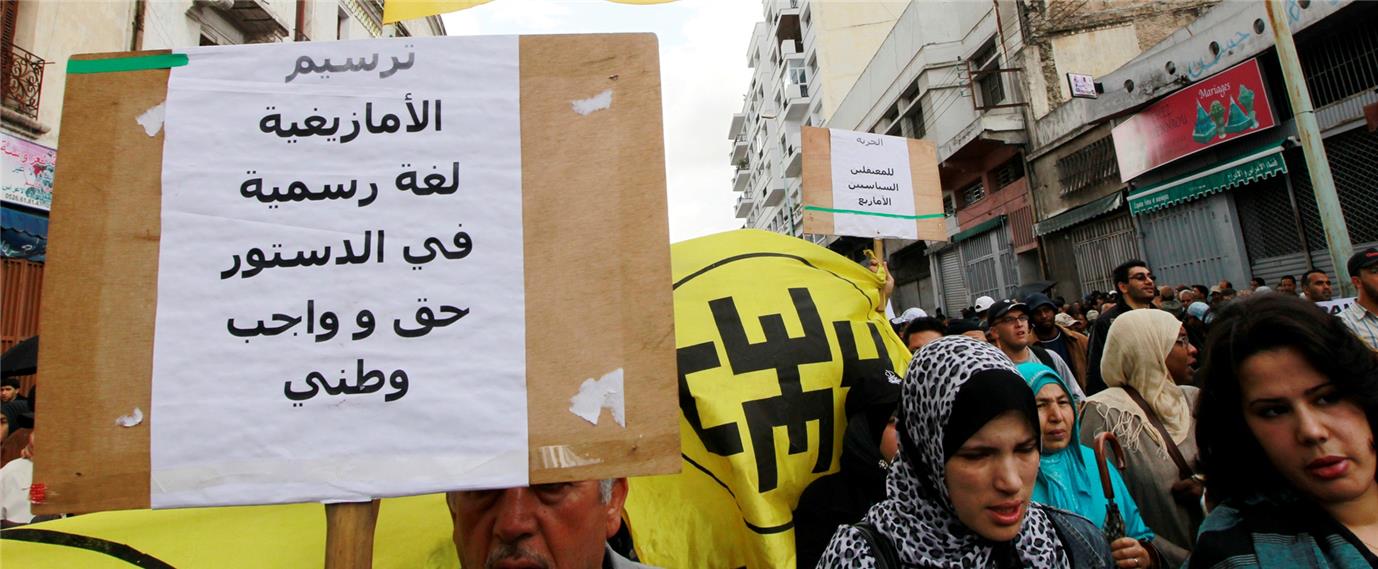تمكن أمازيغ المغرب من تحقيق مجموعة من مطالبهم، خصوصا في قطاع الإعلام السمعي البصري العمومي، إذ أطلق المغرب عام 2010 قناة أمازيغية، بالإضافة إلى إدراج نشرات بالأمازيغية في قنوات عمومية أخرى. لكن ذلك لم يمنع من تسجيل اختلالات تعيق تطوير الإنتاج الأمازيغي في السمعي البصري.
تحققت مكتسبات مهمة لأمازيغ المغرب، بعد مطالب منذ تسعينيات القرن الماضي، لإنصاف لغتهم وثقافتهم خصوصا في قطاعي التعليم والإعلام السمعي البصري. كان من آثار ذلك، على مستوى السمعي البصري خصوصا،إطلاق قناة تلفزيونية عمومية باللغة الأمازيغية عام 2010.
لكن هذا لا يعني، أنه قبل السنة تلك، كانت الأمازيغية مغيبة بشكل كامل عن الإعلام العمومي السمعي البصري، فقد أدرجت نشرة اللهجات الأمازيغية قبل ذلك في القناة الأولى المغربية، ونشرة إخبارية أيضا بالأمازيغية في القناة الثانية المغربية، إضافة إلى تخصيص إذاعة خاصة بالأمازيغية.
الأمازيغية.. في البدء كانت الإذاعة
قطعت الإذاعة الأمازيغية أشواطا مهمة فيما يخص التواصل مع مستمعيها، منذ أن أحدث الاحتلال الفرنسي عام 1938، إلى جانب القسمين الفرنسي والعربي، ما يمكن أن نعتبره –تجاوزا- قسما أمازيغيا، إذ كانت البداية ببث برامج بالأمازيغية لا تتجاوز آنذاك عشرة دقائق بتعبير "تشلحيت" (أمازيغية جنوب المغرب)، ثم ستخصص عشرة دقائق أخرى عام 1952 لتعبير "تمزيغت" (وسط)، وفِي سنة 1955 ستخصص عشرة دقائق أيضا لتعبير "تاريفيت" (شمال).
يقول محمد الغيداني، في كتابه "الإعلام السمعي البصري الأمازيغي ومسألة الهوية"، "هنا لا يمكن الحديث عن إذاعة أمازيغية بالشكل المتعارف عليه؛ أستوديو خاص وأمواج بث خاصة، ولكن كانت البداية ببرمجة مقطوعات غنائية ضمن فترات بث برنامج راديو ماروك".
بعد استقلال المغرب، تحديدا عام 1974 سيرتفع حجم البث الأمازيغي إلى اثني عشر ساعة بمعدل أربع ساعات يوميا لكل تعبير، إذ يبدأ الإرسال من منتصف النهار ويستمر إلى منتصف الليل، والذي لم يعد مقتصرا على الأغاني الأمازيغية فقط كما في العهد الاستعماري. وابتداء من يوم 15 نوفمبر/تشرين الثاني 2005، شرعت الإذاعة الأمازيغية في خوض تجربة تمديد فترات بث برامجها، ما مكن الإذاعة من التواصل مع مستمعيها على مدى ست عشرة ساعة، تبدأ من الثامنة صباحا إلى غاية منتصف الليل، وبذلك أصبح لكل من التعبيرات الأمازيغية الثلاث خمس ساعات من الإرسال يوميا.
بالنظر إلى هذه التجربة المهمة للإذاعة الأمازيغية، فإنها إلى يومنا هذا لم تتمكن من الوصول إلى بث برامجها 24/24 ساعة، ما يجعل محدودية ساعات بثها "تحرمها من استغلال الفترات الصباحية المبكرة والليلية للتواصل المستمر مع مستمعيها". يشير الإعلامي الأمازيغي، محمد الغيداني، الذي شدد على أن الإذاعة الأمازيغية "عملت على مسايرة التحولات التي يعرفها المغرب، من خلال مجموعة من الإنتاجات البرامجية الهادفة إلى تحقيق تجاوب كبير مع المستمعين وطنيا وخارجيا، على صعيد الجالية المغربية المقيمة بالخارج، خاصة إذا علمنا أن نسبة هامة منهم تنحدر من المناطق الأمازيغية المغربية".
إلى جانب الإذاعة الأمازيغية، أدرج راديو دوزيم، التابع للقناة الثانية المغربية في مايو/أيار 2012 نشرة يومية بالأمازيغية، تُبث على الساعة الواحدة زوالا بالتوقيت المحلي.
نشرة اللهجات.. خطوة أولى في التلفزيون
كظلت الثقافة الأمازيغية، إلى حدود زمن ليس بالبعيد، تُسمع ويسمع عنها، وتُحكى ويحكى عنها، ولكن لا تُرى في حقيقتها وعمقها على الشاشتين الصغيرة والكبيرة. وفِي 20أغسطس/آب 1994، سيتم إدراج "نشرة اللهجات الأمازيغية" في القناة التلفزيونية المغربية الأولى، بقرار من العاهل المغربي الراحل الحسن الثاني.
بعض المتتبعين للشأن الإعلامي والسياسي، اعتبروا أن تخصيص هذه النشرة التلفزيونية بالأمازيغية الأولى من نوعها آنذاك، جاء استجابة غير مباشرة لمطلب تمكين الأمازيغية من الحضور في الإعلام السمعي البصري. لكن صاحب كتاب "الإعلام السمعي البصري الأمازيغي ومسألة الهوية"، يعتبر أنه "لا يمكن بحال من الأحوال ادعاء أن 15 دقيقة للنشرة الأمازيغية أو أقل، بالرغم من ثوبها الأمازيغي، تحيل على كينونة الإعلام ذي الطابع المتميز، إذ يغلب عليه طابع الترجمة".
بعد أزيد من عقد من تجربة اللهجات هذه، ستشرع قناة محمد السادس للقرآن الكريم "السادسة" ببث برامجها فِي نوفمبر/تشرين الثاني 2005؛ ومنها برامج دينية باللغة الأمازيغية. كما انطلقت تجربة أخرى للنشرة الأمازيغية في 25 ديسمبر/كانون أول 2006 على القناة الثانية المغربية.
تمازيغت.. مسار قناة أمازيغية
يرى الإعلامي الأمازيغي، محمد الغيداني، أنه "لا يمكن الحديث عن برمجة أمازيغية تلفزيونية قبل عام 2010؛ هذه البرمجة بصيغتها المهنية المتعارف عليها لم تَر النور إلا مع بداية القناة الثامنة تمازيغت". وقد جاء مشروع إحداث قناة أمازيغية، تتويجا لمسار متعدد المراحل والمحطات التاريخية.
في 17ديسمبر/كانون أول 2007، انعقد اجتماع بتعليمات من الملك بين الوزير الأول وعميد المعهد الملكي للثقافة الأمازيغية، لتدارس الاعتمادات المالية الكفيلة بانطلاق المشروع، مع الاتفاق على انطلاق البث في 14 يناير/كانون الثاني 2008.
مرة أخرى لم تنطلق قناة الأمازيغ في التاريخ المحدد، وانتظرت تمازيغت سنتين لكي ترى النور، فكان بثها التجريبي يوم 6 يناير/كانون الثاني 2010، ثم البث الفعلي في فاتح مارس من ذات العام.
الإرادة السياسية والمرتكزات المهينة
يرى محمد الغيداني، في كتابه "الإعلام السمعي البصري الأمازيغي ومسألة الهوية"، أنه "من شأن القناة الأمازيغية، أن تخدم التنوع الثقافي واللغوي بالمغرب، وتعكس الثراء المادي والمعنوي للثقافة المغربية، وتساهم بدون شك في تطوير اللغة الأمازيغية وتثمين ونشر الثقافة الأمازيغية بشكل أوسع داخل الأوساط المختلفة للمجتمع المغربي".
لكن في الواقع، تبدو الأمازيغية في الإعلام السمعي البصري العمومي، بدون مرتكزات مهنية وتقنية قوية، استنادا إلى أن التصور المبدئي لدى المسؤولين لم يكن مبنيا على همِّ مهني، بل فقط جاء لتلبية طلب سياسي وامتصاص شكلي لمطالب الحركة الأمازيغية.
يعتبر إبراهيم المرابط، رئيس المركز الأمازيغي للإعلام الأمازيغي، أن الإعلام العمومي السمعي البصري "يتعامل مع الأمازيغية بمنطق ما قبل دستور 2011، فلا شيء تغير على الإطلاق، والوضع هو نفسه سواء في القناة الأولى والثانية وكذا في الأمازيغية الثامنة أيضا، هذا إن لم نقل إن الوضع صار أسوأ".
ويضيف المرابط، في تصريح لـ"مجلة الصحافة"، أنه "إلى حدود اليوم نجد غيابا تاما لبرامج أمازيغية حقيقية ومؤثرة وذات مستوى عال في قنوات القطب العمومي، إضافة إلى أن برامج القناة الثامنة الأمازيغية تراجع مستواها بشكل واضح وجلي، تراجع نراه في التذمر الذي ما ينفك المشاهد المغربي يعبر عنه في كل مناسبة".
كما نبه المراقبون في مناسبات عدة، إلى أنه من أسس بناء إعلام سمعي بصري أمازيغي حقيقي، إضافة إلى الإرادة السياسية الفعلية، الاعتماد على موارد بشرية مهنية، لكن تجربة الأمازيغية في السمعي البصري وحتى المكتوب، كشفت على أن الساحة النضالية (الحركة الأمازيغية)، هي المدرسة الأولى للإعلام التلفزيوني (القصد هنا تحديدا القناة الأمازيغية)، مع استثناءات قليلة جدا ممن انغمس في تجربة الإعلام الأمازيغي من خريجي معاهد الإعلام.
بهذا الخصوص، يقول المرابط، "للأسف فالإعلام الأمازيغي بدأ بالإعلاميين المناضلين، ولم ينتقل إلى الإعلاميين المهنيين كما كان متوقعا، زيادة على أن الشركات التي تفوز بصفقة البرامج، لا تبحث عن الصحفي المهني ولا حتى عن المناضل، بل تبحث عن الأقل سعرا، فضاع الإعلام الأمازيغي بين المناضل وجشع شركات الإنتاج".







































